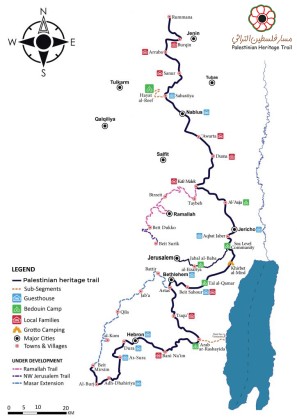About Us

Palestinian Heritage Trail (PH Trail) is a not-for-profit community-based tourism organization (union) that delineates and develops a hiking trail in Palestine that is called “Palestinian Heritage Trail” in and around different Palestinian localities. We work closely and jointly with more than 50 local communities to endorse cultural diversity and exchange, safeguard tradition and heritage, inspire storytelling, and encourage friendships based on advancing human values and preserving the surrounding environment and the people’s needs for further growth and education. PHT works closely and jointly with local communities to cultivate their resources, capacities, and the opportunity for a better life.
Walking the trail takes travelers down the Palestinian cultural heritage lane and gives a taste of the local identity that is believed to be preserved in the soil and earth walked on. Such experience invites voyagers to discover the simple, yet warm, life of the local communities and the traditional hospitality from the heart of the Palestinian people.
Vision: Creating a vibrant Palestinian community in a sustainable environment, emphasizing the enticing experience of Palestine’s identity and its historical cultural heritage alongside the Palestine Heritage Trail.
Mission: Developing and promoting community-based tourism through the Palestine Heritage Trail.
Yet, in the process of fulfilling its mission, the Palestine Heritage Trail also contributes to:
- Empower women, youth, and households and diversify their livelihood opportunities.
- Build bridges between Palestinian communities along the trail, other Palestinian communities, and guests from abroad.
- Create awareness, among Palestinians and guests from abroad, about Palestinian identity, history, and ways of living.
The Palestinian Heritage Trail partners and brings together the efforts, work, and achievements of three organizations working in unison:
- The Palestinian Center for Rapprochement between People/ Siraj Center
- Rozana Association
- Palestine Wildlife Society
Logo: picture of the logo and what it represents in a sentence.
- The Poppy flower (Hanoun in Arabic): The Hanoun flower symbolizes development and reflects the enriched variety of wildlife and landscape in Palestine.
- The Green, red, and black colors in the flower: are the Palestinian flag colors, which reflect the deeply rooted in history Palestinian identity.
- The stones: are mostly seen in ancient Palestinian houses and alongside the trail as an old Palestinian protection method of any dirt drifts. The stones in the logo are convenient for PH Trail since it aims for cultural preservation.
Address: Al Karamah Street- Beit Sahour, Palestine.
DISCLAIMER
The Palestinian Heritage Trail (PHT) understands that hiking and trekking can be risky. People who take part in such activities need to realize and accept these risks and be responsible for their actions. Additionally, PHT does not recommend people with health issues to hike any segment of the trail without the professional assistance of a guide.
The Palestinian Heritage Trail recognizes that certain walking paths may pose safety hazards for some hikers due to the risk of slipping and falling. In some instances, these dangers can lead to the risk of death.
Familiarize Yourself with Trail Markings:
If you choose to explore the PH Trail, it's essential to understand the following:
The PH Trail is a dynamic long-distance walking trail that traverses various properties between villages, both on private and public lands, which can impact the trail's condition. Accordingly, the trail undergoes year-round changes, necessitating periodic detours to ensure safety and accessibility.
The PH Trail is a formidable challenge. To hike the entire trail, one must be prepared for a lengthy and energetic journey characterized by significant elevation changes. The trail includes a variety of terrains, including footpaths, dirt paths, paved roads, wilderness areas, desert areas, slippery and steep descents and ascents, rocky passages, crossing tiny irrigation water canals, and other terrain types.
In some sections, clear pathways may not be evident, and you will rely solely on the trail markings. This is crucial to keep in mind. Please note that we regularly update the trail information to align with the current physical trail markings in each section. Should you come across any discrepancies or encounter issues along the trail, such as missing trail markings or trail damage, please don't hesitate to contact us. New road construction, excavations, or misuse of land may result in the disappearance of some trail markings, and your assistance in reporting such matters, along with location details and photos if available, is greatly appreciated.



